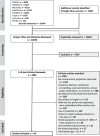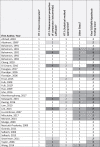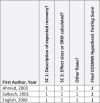Distance-limited walk tests post-stroke: A systematic review of measurement properties
- PMID: 33967070
- PMCID: PMC8293643
- DOI: 10.3233/NRE-210026
Distance-limited walk tests post-stroke: A systematic review of measurement properties
Erratum in
-
Erratum to: Distance-limited walk tests post-stroke: A systematic review of measurement properties.NeuroRehabilitation. 2022;51(2):351. doi: 10.3233/NRE-228023. NeuroRehabilitation. 2022. PMID: 36120794 Free PMC article. No abstract available.
Abstract
Background: Improving walking capacity is a key objective of post-stroke rehabilitation. Evidence describing the quality and protocols of standardized tools for assessing walking capacity can facilitate their implementation.
Objective: To synthesize existing literature describing test protocols and measurement properties of distance-limited walk tests in people post-stroke.
Methods: Electronic database searches were completed in 2017. Records were screened and appraised for quality.
Results: Data were extracted from 43 eligible articles. Among the 12 walk tests identified, the 10-metre walk test (10mWT) at a comfortable pace was most commonly evaluated. Sixty-three unique protocols at comfortable and fast paces were identified. Walking pace and walkway surface, but not walkway length, influenced walking speed. Intraclass correlation coefficients for test-retest reliability ranged from 0.80-0.99 across walk tests. Measurement error values ranged from 0.04-0.40 and 0.06 to 0.20 for the 10mWT at comfortable and fast and paces, respectively. Across walk tests, performance was most frequently correlated with measures of strength, balance, and physical activity (r = 0.26-0.8, p < 0.05).
Conclusions: The 10mWT has the most evidence of reliability and validity. Findings indicate that studies that include people with severe walking deficits, in acute and subacute phases of recovery, with improved quality of reporting, are needed.
Keywords: Gait; assessment; measurement properties; rehabilitation; stroke.
Conflict of interest statement
NMS is an author on 5 articles included in this review. DKC is an author on 1 article included in this review. PT is an author on 1 article included in this review. Otherwise, the authors declare no conflicts of interest. Funding for this project is provided by the Canadian Institutes of Health Research, Heart & Stroke Foundation, Canadian Partnership for Stroke Recovery, and Canadian Frailty Network. NMS holds the Toronto Rehabilitation Institute Chair at the University of Toronto.
Figures




References
-
- Agyenkwa, S. K., Yarfi, C., Banson, A. N., Kofi-Bediako, W. A., Abonie, U. S., Angmorterh, S. K., & Ofori, E. K. (2020). Assessing the use of standardized outcome measures for stroke rehabilitation among physiotherapists in Ghana. Stroke Research and Treatment, 10.1155/2020/9259017 - DOI - PMC - PubMed
-
- Ahmed, S., Mayo, N. E., Higgins, J., Salbach, N. M., Finch, L., & Wood-Dauphinée, S. L. (2003). The Stroke Rehabilitation Assessment of Movement (STREAM): a comparison with other measures used to evaluate effects of stroke and rehabilitation. Physical Therapy 83(7), 617–630. - PubMed
-
- Beaton, D. E., Bombardier, C., Katz, J. N., Wright, J. G., Wells, G., Boers, M., Strand, V., & Shea, B. (2001). Looking for important change/differences in studies of responsiveness. The Journal of Rheumatology 28(2), 400–405. - PubMed
Publication types
MeSH terms
LinkOut - more resources
Full Text Sources
Medical

